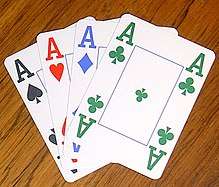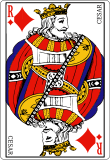Diamonds (suit)
Diamonds ![]()
![]()
![]()

The original French name of the suit is Carreau; in German it is known as Karo.
In older German-language accounts of card games, Diamonds are frequently referred to as Eckstein ("cornerstone"). In Switzerland, the suit is still called Egge (=Ecke i.e. "corner") today. The term "Karo" went into the German language in the 18th century from the French carreau, which goes back to the Latin word, quadrum, meaning "square" or "rectangle".[1]
Characteristics

The diamond typically has a lozenge shape, a parallelogram with four equal sides, placed on one of its points. The sides are sometimes slightly rounded and the four vertices placed in a square, making the sign look like an astroid.
Normally diamonds are red in colour. They can however be depicted in blue,[2][3] which is the case for example in bridge (where it is one of the two minor suits along with Clubs). In the official Skat tournament deck, diamonds are yellow or orange, assuming the color of their German-deck equivalent, which are usually golden.
The following gallery shows the diamonds from a 52-card deck of French playing cards. Not shown is the Knight of Diamonds used in the tarot card games:
 Ace
Ace 2
2 3
3 4
4 5
5 6
6 7
7 8
8 9
9 10
10

 King
King
Coding
The symbol ♦ is already in the CP437 and therefore also part of Windows WGL4. In Unicode a black ♦ and a white ♢ diamond have been defined:
| Symbol | Unicode | Entity in HTML |
|---|---|---|
| ♦ | U+2666 BLACK DIAMOND SUIT | ♦ or ♦ |
| ♢ | U+2662 WHITE DIAMOND SUIT | ♢ |
References
- Wolfgang Pfeifer: Etymologisches Wörterbuch des Deutschen. 8. Auflage. Deutscher Taschenbuch Verlag, Munich, 2005, ISBN 3-423-32511-9.
- Sfetou, Nicholas. The Bridge Game.
- Trialling the four-colour deck at www.pokerstars.com. Retrieved 11 Jun 2018.
External links
| Look up Diamond in Wiktionary, the free dictionary. |